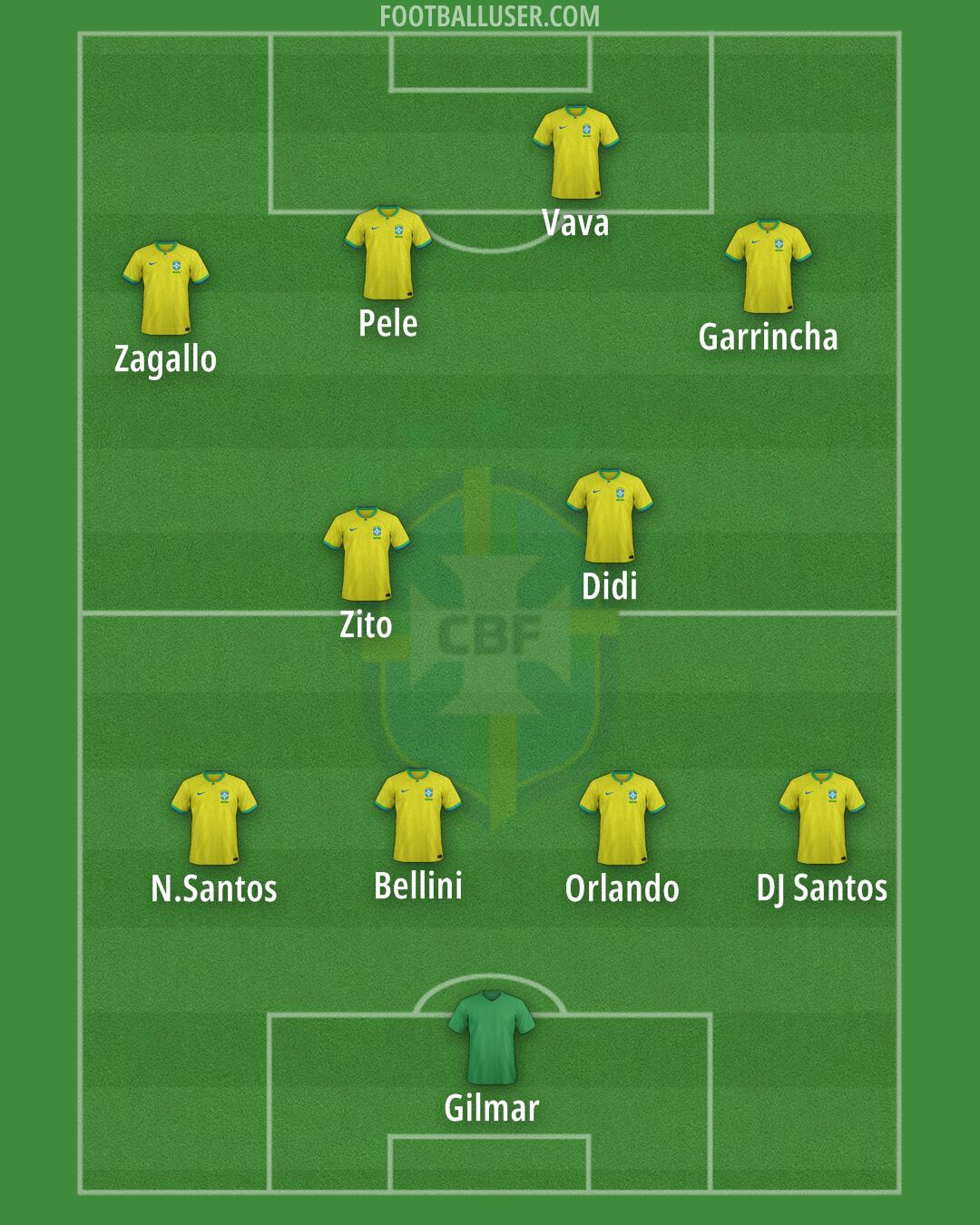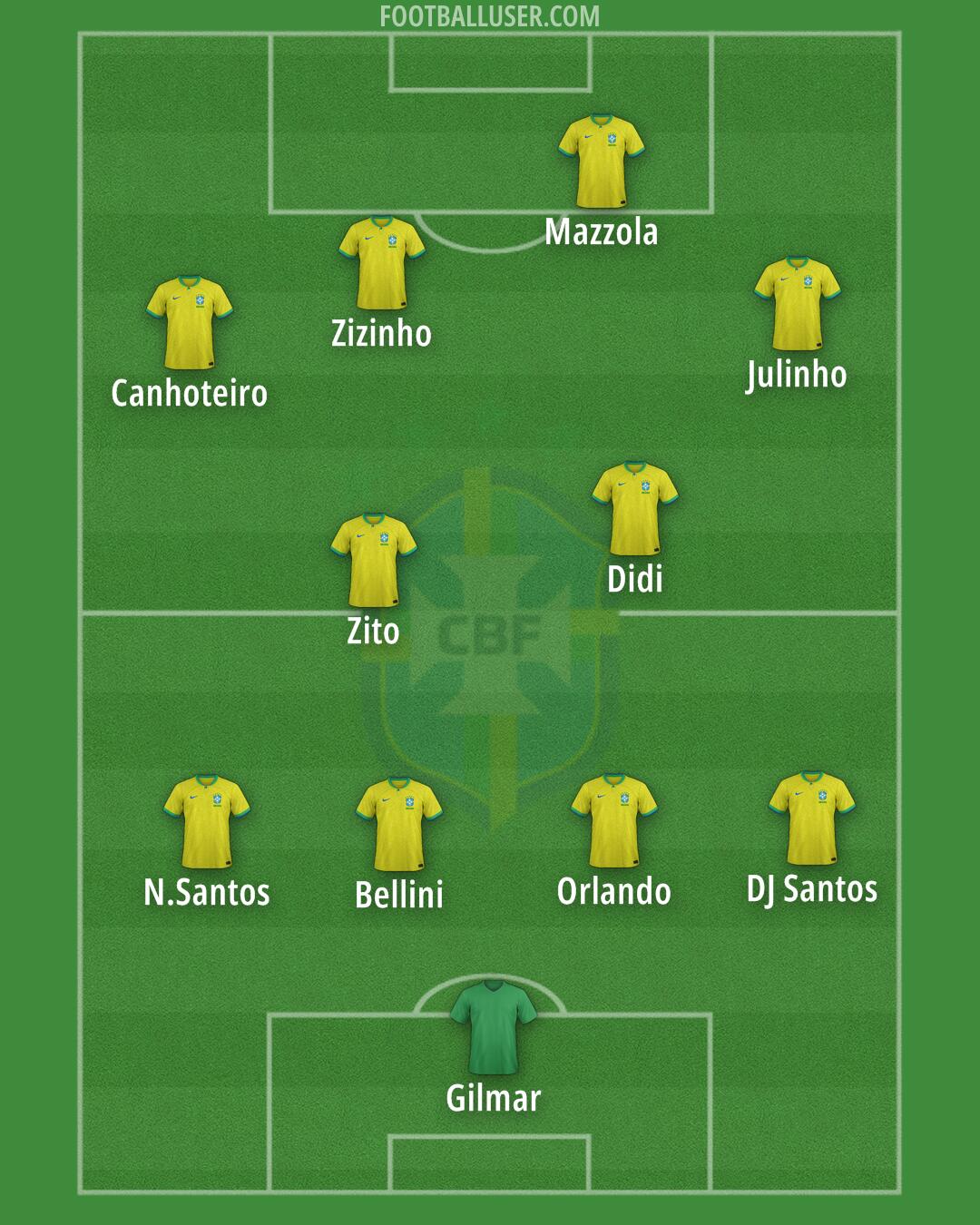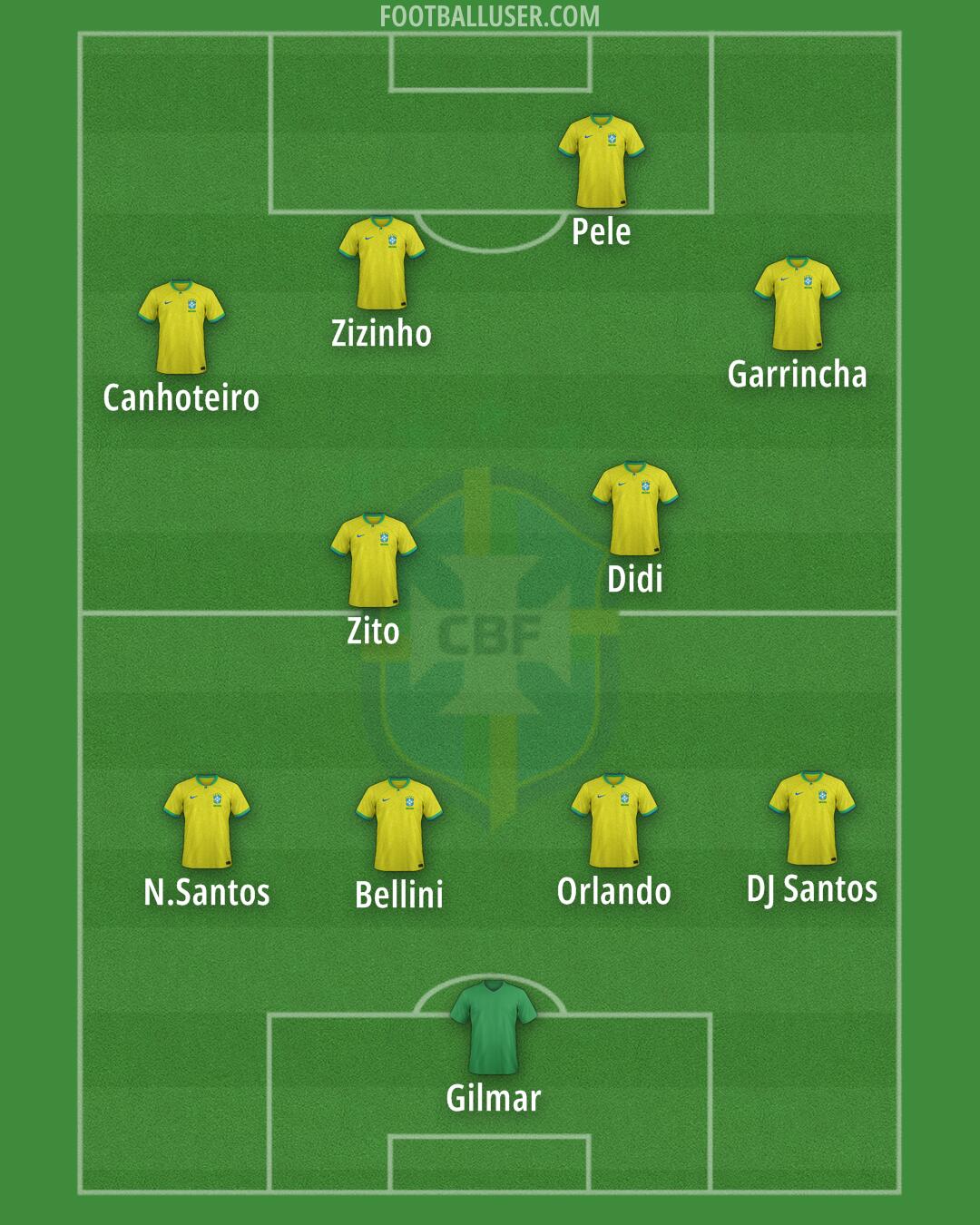 |
| 1958 World Cup Finals |
Sao Paulo State, Rio de Janeiro
North/Northeastern Brazil, South/Southeastern Brazil
Brazilian-born players capped by other national teams
Afro-Brazlian Players
Brazil All-Team Under Mari Zagallo
Austria-Hungary World Cup 1954
Angels with Dirty Faces with Di Stefano in the WC 1958
Brazil World Cup 1958
United Kingdom World Cup 1970
England World Cup 1974
United Kingdom World Cup 1982
Italy Euro 1992
Yugoslavia World Cup 1994
France World Cup 1994
Germany World Cup 2002
Netherlands World Cup 2002
Carlos Jose Castilho went to 4 World Cup Finals: 1950, 1954, 1958 and 1962, but only played in 1954. He had a reputation for being lucky, earning the nickname "Leiteira". He played over 695 games for Fluminense. He was diatonic and he believed he was favored because he saw yellow balls as if they were red, though he had trouble at night with white balls. He also decided to partially amputate a finger so that he did not need to rest for an injury.
GK: Gilmar (Corinthians)
 |
| Gilmar |
De Sordi earned 22 caps for the Brazil national football team. He was part of the 1958 FIFA World Cup winning squad with Pele, Garrincha and Didi. He played in all matches except the Final against the host Sweden. During his club career he played for XV de Piracicaba-SP and São Paulo. He played over 500 games for Sao Paulo between 1952 and 1965.
During his club career Orlando Peçanha played for Vasco da Gama (1955–1960), Boca Juniors (1960–1964) and Santos (1965–1967). With Boca Juniors, he was their captain at one point. He was part of the Brazilian team that won the 1958 FIFA World Cup, and also participated in the 1966 FIFA World Cup as the vice captain of the team. In total he earned 30 caps.
Mauro Ramos was considered one of Brazil's greatest centerbacks. He went to both 1954 and 1958 World Cup Finals without playing a game, but in the World Cup Finals of 1962, he lifted the World Cup trophy as Brazil's captain. He was capped 22 times. For his club career, he played for Santos and Sao Paulo. At Santos, he was a part of Pele's great Santos team in the 1960's.
Bellini was Brazil's captain for the World Cup Finals in 1958. He was credited for starting the tradition of lifting the trophy high in the air, making the gesture winning symbol. He won another World Cup in 1962 and participated also at 1966 FIFA World Cup as the team captain again. He had 51 caps between 1957 and 1966. During his career he played for Vasco da Gama, São Paulo FC and Atlético Paranaense.
 |
| Bellini and De Sordi |
LB/MF: Oreco (Corinthians)
Oreco began his career at the Santa Maria, where he played for a year. He then played for Internacional of Porto Alegre, for which he played for seven years and won five Rio de Janeiro championships in that period. He was also a Corinthians player for eight years. He also played for Dallas Tornado, winning the NASL Cup. At the international level, he won the 1958 World Cup as Nilton Santos' backup.
With Brazil, Zito earned 52 caps between 1955 and 1966. He was a big part of the team that won the World Cup in 1958, and 1962. He played almost his entire career with Santos between 1952 and 1967. He was the captain of the "Os Santásticos" team of the late 1950s and 1960s, playing alongside Pelé, Pepe and other Brazilian stars. He was known as a leader that a young Pele respected throughout his career. He was his mentor.
 |
| Zito |
 |
| Didi |
AM: Zizinho (São Paulo)
Zizinho was Pele's idol. He was considered the greatest Brazilian player before the 1960's. He was the star of the ill-fated World Cup Finals in 1950 playing alongside Jair and Ademir. It was one of Brazil's greatest attack line. He played for Flamengo, Bangu, São Paulo FC, Audax Italiano of Chile among others teams. With, Flamengo, he won state championships in 1942, 1943 and 1944. With Brazil, he had 53 caps between 1942 and 1957.
RW: Julinho (Fiorentina)
During his career (1951–1967), Julinho played for Portuguesa, Fluminense and Palmeiras. His greatest spell was with Fiorentina. He was nominated as the best player in the history of Fiorentina in 1996. He was one of the greatest wingers in Serie A history. He had 24 caps for Brazil. He was one of the best player at the World Cup Finals in 1954. He turned down a chance to play in the 1958 World Cup Finals in Sweden, giving the way for Garrincha to shine.
RW: Garrincha (Botafogo)
Garrincha is considered one of the greatest footballers and perhaps the greatest dribbler in history. He inspired Brazil to win the World Cup in 1962, which widely considered the best individual effect in World Cup history. He was the Player of the Tournament that year. He also played in 1958 and 1966. Brazil never lost a single match with Pele and Garrincha on their lineup. At the club level, he was a member of the great Botafogo's team in the 1960's.
 |
| Garrincha |
Evaristo played for Madureira and Flamengo before moving to Barcelona in 1957, where he stayed until 1962. Then, in 1962, he left Barcelona for Real Madrid, where he played between the two European Cup winning teams. He was capped by Brazil 14 times, scoring 8 goals. He also holds the record of most goals for the Brazilian national team in one single game, as he netted five times for the Seleção in a 9–0 win against Colombia in 1957.
Mario Zagallo played 33 times for Brazil between 1958 and 1964. was involved in 4 of Brazil's 5 World Cup titles. He won 1958 and 1962 edition as a player. In 1970, he was their head coach. And in 1994, he served as an assistant coach. For his club career, he played for America, Flamengo and Botafago. He was a member of the great Botafago team of the 1960's that also featured Garrincha and Didi. He played for them between 1958 and 1965.
 |
| Mario Zagallo |
ST: Mazzola "Jose Altafini" (Palmeiras)
He started his career with Palmeiras before joining AC Milan right after the WC Finals in 1958. From 1958 to 1976, he scored 216 goals in Serie A making him the joint-fourth highest scorer in Serie A history. He won the European Cup in 1963, scoring 14 goals, which was finally broken by Cristano Ronaldo in 2014. He made played for Brazil, using the name "Mazzola". In 1962, he played for Italy at the World Cup Finals. He earned 6 caps for Italy scoring 5 goals.
 |
| Nilton and Djalma Santos |
 |
| Julinho |






No comments:
Post a Comment